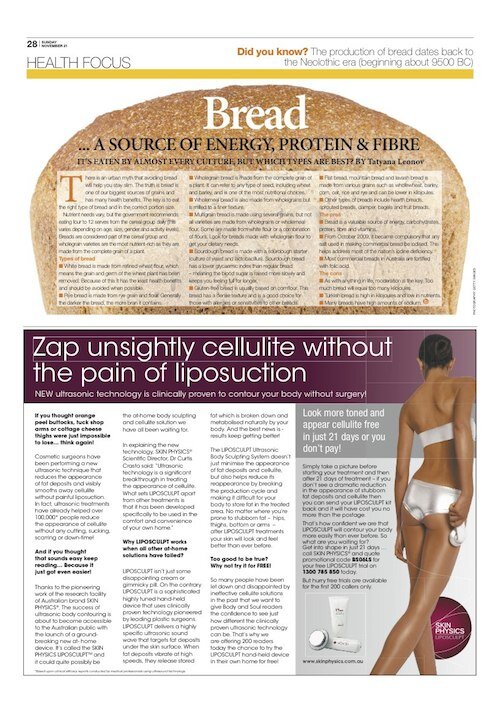Bread
Bread is probably one of the few foods eaten by people of every race, culture and religion. But is it good for us?
There’s an urban myth that avoiding or limiting bread will help us stay slim. The truth is bread is one of our biggest sources of grains with many health benefits. The key is to eat the right types of breads and in the correct portion sizes. Nutrient needs vary for individuals but the Australian Government recommends we eat four to 12 serves from the cereal group daily (these vary depending on age, size, gender and activity levels). Breads are counted as part of the cereal group and wholegrain varieties are the most nutrient-rich because they are made from complete grain of a plant. All three parts of the grain – the bran, the endosperm and the germ are used. Keep in mind that different types of breads will have different health benefits so always read the label. And don’t stress too much – a variety of breads eaten in moderation will get the best results.
Types Of Bread
• White bread is made from refined wheat flour, which means the grain and germ of the wheat plant has been removed. Because of this it has the least health benefits and should be avoided when possible. You can also get fibre-increased white bread, which includes the addition of fibre-containing compounds.
• Rye bread can be made with various percentages of rye grain and flour. Generally the darker the bread, the more bran has been left in – so go dark if you can. It’s also usually higher in fibre when compared to other breads and fibre keeps the digestive system healthy by aiding the excretion of waste and toxins from the body.
• Wholegrain bread is made from the complete grain of a plant. It can refer to any type of seed – wheat, rye, barley etc and is one of the most nutritional choices.
• Wholemeal bread is also made from wholegrains but milled to a finer texture so has the same benefits as wholegrain bread.
• Multigrain bread is made using several grains but not all varieties are made from wholegrains or wholemeal flour. Some are made from white flour or a combination of flours. Look for breads made with wholegrain flour to get your dietary needs.
• Sourdough bread is made with a sourdough starter (culture of yeast and lactobacillus). The mixture goes through a fermentation process that produces a gas and an acid. The gas is then trapped in the gluten – causing the bread to rise. This mixture is then used as a starter to leaven other breads. Sourdough bread is another healthy option; it has a lower glycemic index – meaning the blood sugar is raised more slowly when compared to other breads, and in wholegrain sourdough varieties there is better absorption of minerals because the sourdough breaks down the phytic acid that is found in wholegrains.
• Recently gluten-free bread has grown in popularity. Usually based on cornflour this bread has a thicker, denser texture and is a good choice for those with allergies or sensitivities to other breads.
• Some other types of breads include hearth breads, flat breads sprouted breads, damper, bagels and fruit breads – but there are many more.
The Pros
• Bread is a valuable source of energy, carbohydrates, protein and vitamins.
• The Australian Guide to Healthy Eating recommends we eat plenty of (preferably wholegrain) cereals. This includes breads, rice and pasta.
• A Norwegian study found that people who ate a high amount of wholegrain foods reduced their risk of death from heart disease and cancer by 25 per cent, therefore wholegrain bread is a good option.
• The outer layer of grains are full of dietary fibre, so bread made out of wholegrains works to get the bowel healthy by increasing movement of food through the digestive tract and aiding in the removal of toxins.
• According to the Victorian Government’s Better Health Channel wholegrain food can reduce the risk of developing diseases such as cancer, coronary heart disease, diabetes and diverticular disease.
• As of October 2009 it is compulsory that any salt used in making commercial bread is iodised. This helps address most of the nation’s iodine deficiency.
• Most commercial breads in Australia are fortified with folic acid as of September 2009. The Food Standards Australia New Zealand predicts that mandatory folic acid fortification will help reduce the number of NTD (Neural Teubal Defect)-affected pregnancies by 14 to 49 per year.
• Low GI breads (ones that release carbohydrates slowly) are beneficial as they keep us fuller for longer. Sourdough breads are low GI and some commercial breads have the glycemic index information displayed on the packaging.
The Cons
• As with anything in life moderation is the key. Too much bread will equal too many kilojoules.
• White bread is produced from the whole wheat grain but then refined. This removes the traces of the husk and the goodness contained in the grain. The refined flour is then often bleached using chemicals. The end result is bread stripped of many of its naturally-occurring vitamins and minerals.
• Many breads have high amounts of sodium. Interestingly enough though, according to Leanne Cooper, nutritionist and director of Cadence Health, large numbers of manufactures are joining the food councils push for reduced sodium.
• A high intake of refined cereals has been linked to some types of cancer and diabetes according to the Victorian Government’s Better Health Channel.
• Bread is often eaten with other condiments such as butter or other high-fat spreads.
Did you know?
The production of bread dates back to Neolothic era (beginning about 9500 BC) and is one of the oldest prepared foods in the history of human kind.





